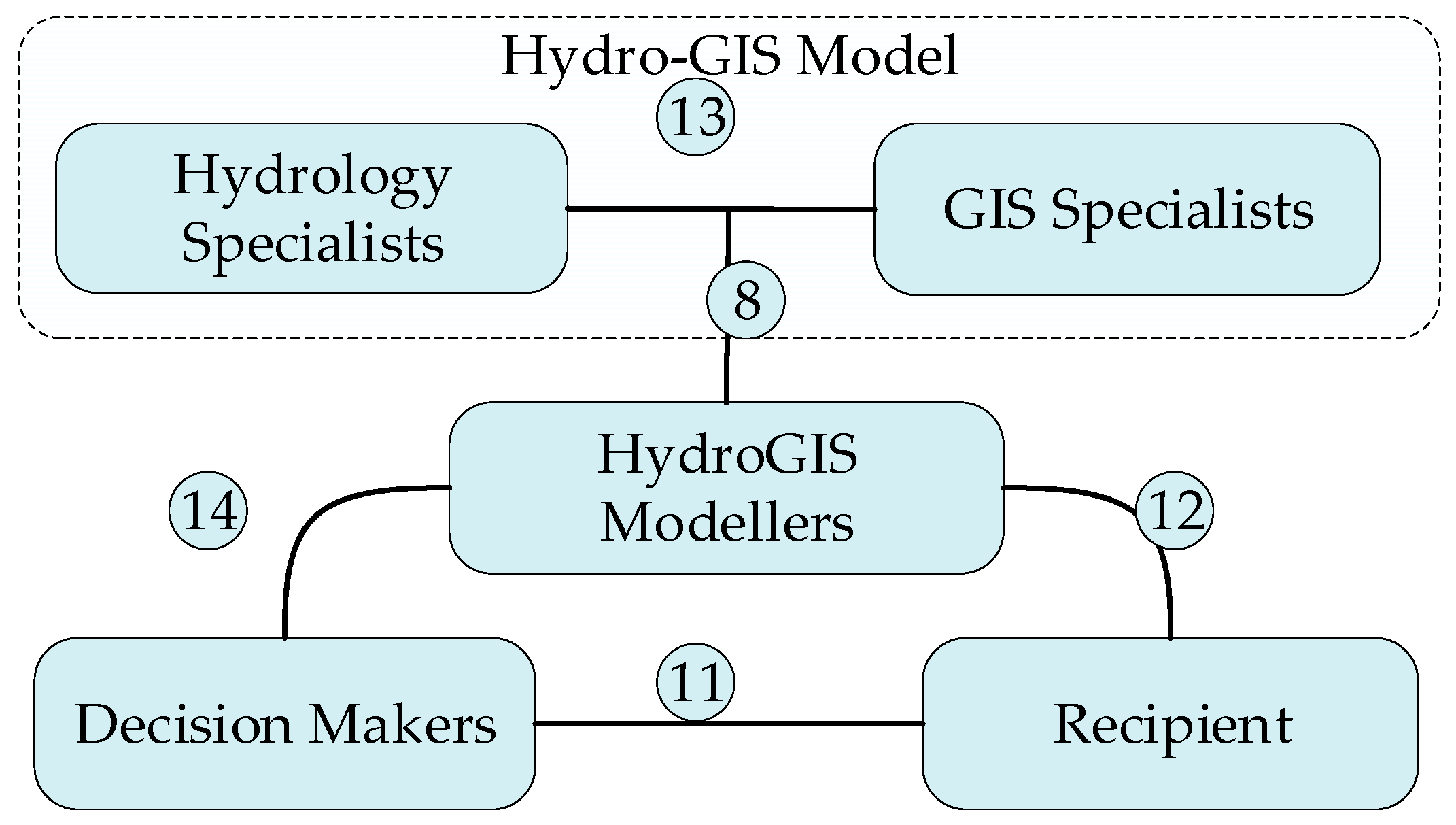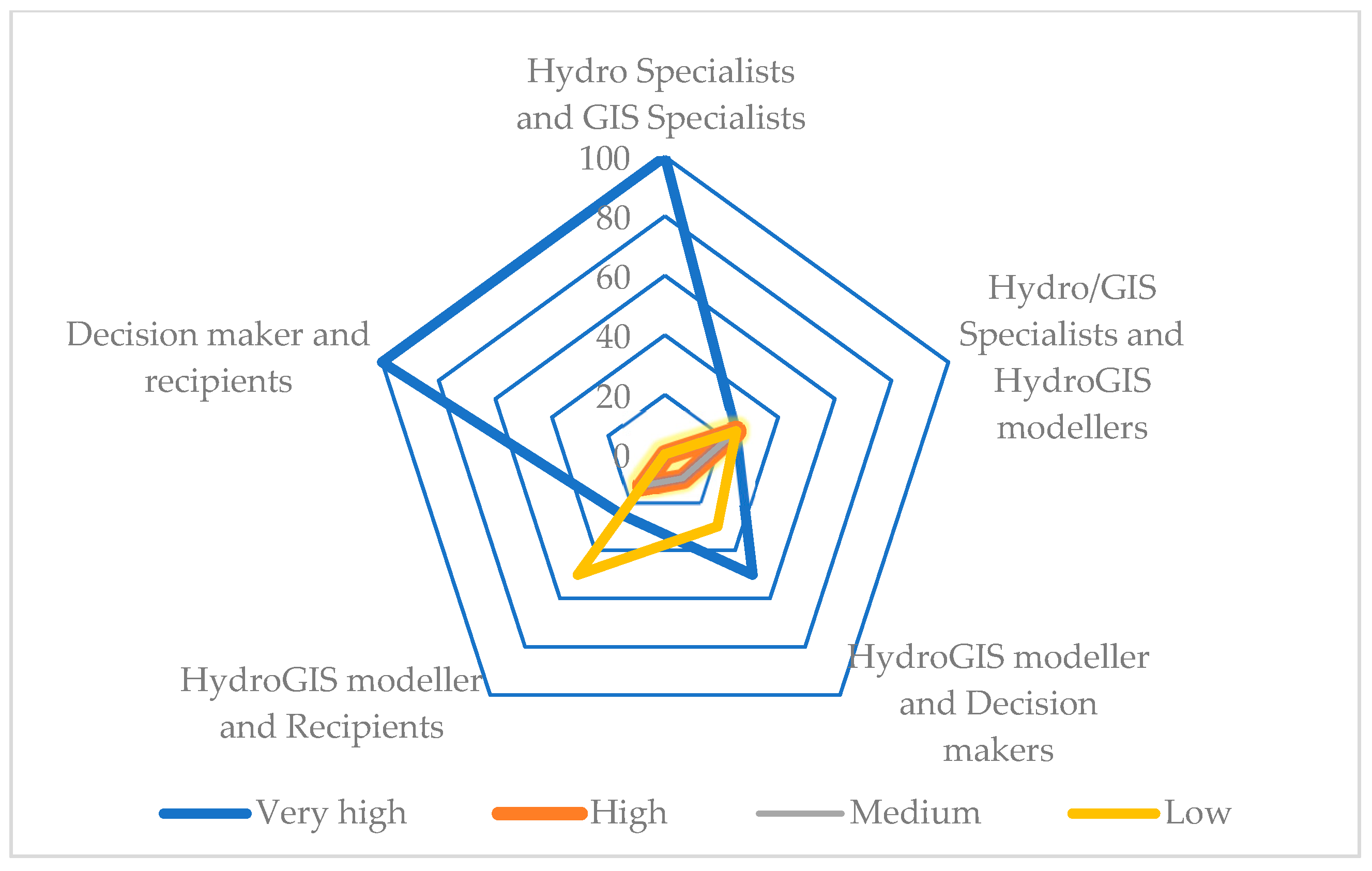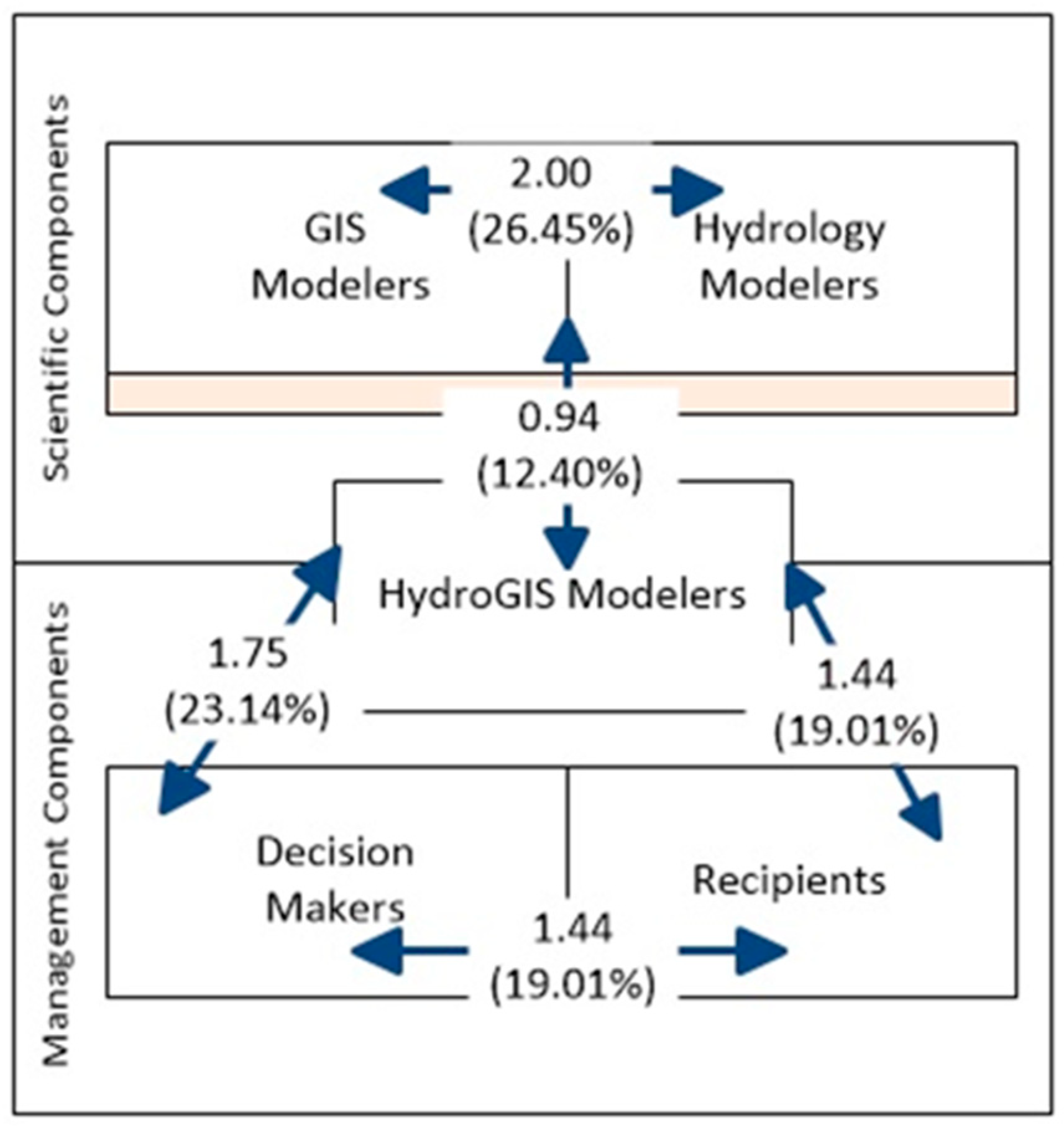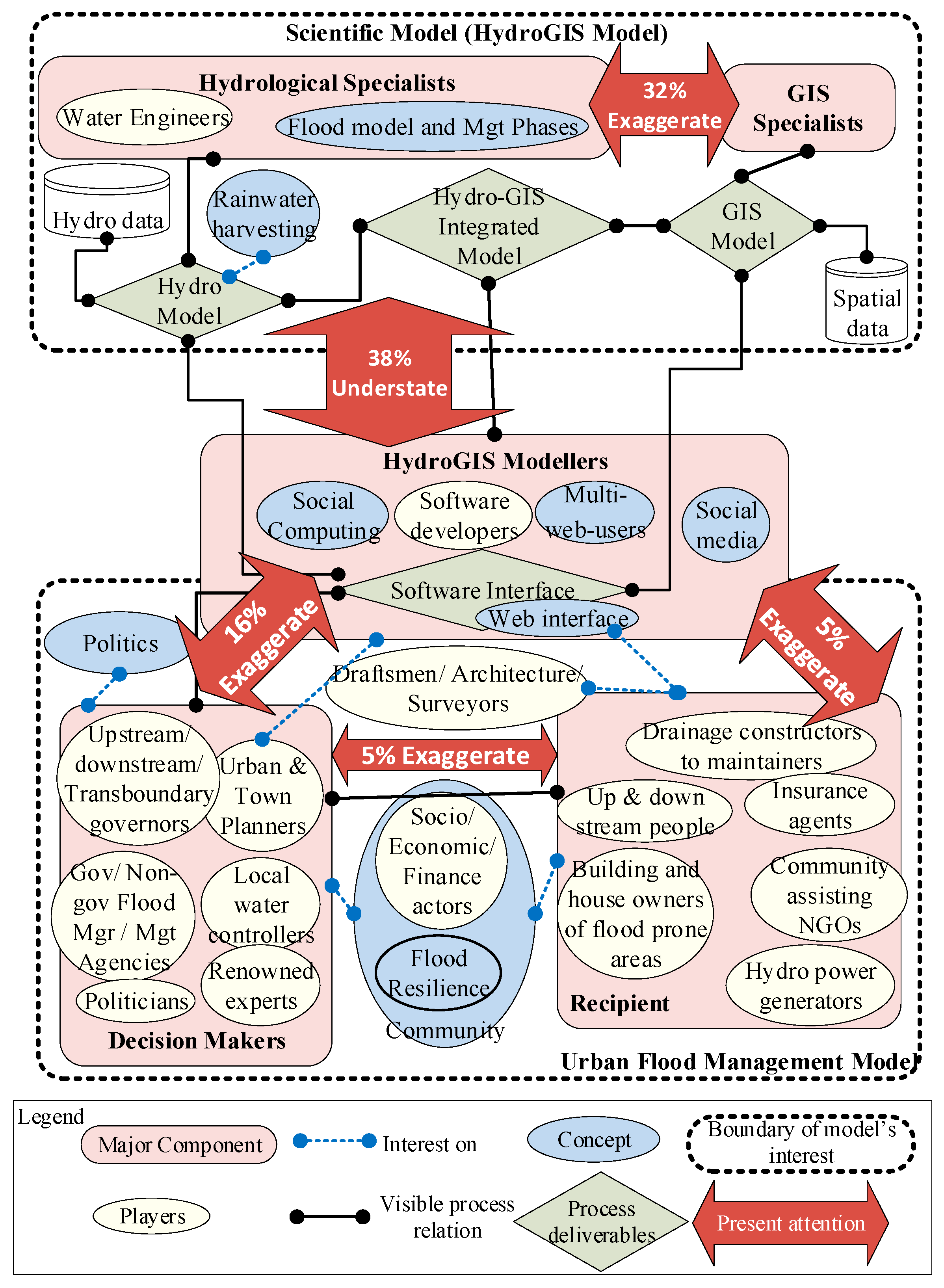1. Introduction
The ultimate aim of the United Nations Sustainable Development Goals (SDG) is the sustainable development of humans in harmony with the environment [
1]. Therefore, one of the key undertakings in water resource management is to maintain a satisfactory relationship between natural water cycle needs and social/economical needs. Scientists and water governors have already been working independently to achieve these goals for decades. Nevertheless, with different influences on research, such as the need to incorporate the general public’s opinion in decision making [
2], as well as stakeholder theory [
3], researchers are used to integrating the two agendas. In the meantime, the 1997 UN water conference and 1992 “Dublin Principles” established an international norm for water governance, namely Integrated Water Resource Management (IWRM) [
4].
Since IWRM is based on water governance for achieving sustainable goals, it is always better to maintain a close relationship between decision makers and key stakeholders while developing management tools to optimise the requirements [
5]. In parallel, various other initiatives, such as Green Infrastructure (GI), Low Impact Development (LID), and the water framework of Economic Co-operation and Development (OECD) [
6,
7], are also in practice; however, an analysis of the available data found that the effects of flood damage on national economies is increasing [
8].
The common excuses for this situation are the recipient stakeholders’ poor participation, that governance discourses are limited to stakeholders, and that decisions are mainly theoretical [
9,
10]. Apart from those, there are dozens of negative reasons for the practical incorporation of recipients’ perspectives in administrative decision-making modelling or processes. Furthermore, we found that no study had been carried out to inductively explore the integrations of the requirements of the total stakeholder profile of the process in the current setting. Therefore, our initial work was carried out to evaluate the integration of stakeholder requirements for a specific area of urban flood management [
11]. As such, the aim of the present work is to analyse and discuss the results for practical stakeholder integrations in IWRM.
2. Methods
2.1. Evaluation of Levels of Stakeholder Requirements Integration
As there is no established method to carry out this type of transdisciplinary research, which needs to evaluate different components in integrated water management decision making, we required an acceptable research methodology. As such, an in-depth study, including a literature review and expert discussion, was carried out to develop a research methodology for gap identification [
12,
13,
14].
Then, accordingly, we carried out abductive research using a sequential multi-phase approach of the mixed method. We employed modified constructivist grounded theory, documentary research, and survey strategies to find and verify the main components and their integration depths in the scientific and management model of urban flood management. For the component identification, we studied the GIS2MUSCLE urban flood management tool, 4 hydro-GIS integration models, and 247 works of research; furthermore, for calibration, we utilised 21 experts. The average integration depths among the components were calculated using 32 studies employing Multi-Attribute Utility Theory (MAUT) and Weighted Average Programming (WAP). Finally, we evaluated the results with 70 experts and analysed the result by employing thematic analysis and Multi-Criteria Group Decision Making (MCGDM) methods.
2.2. Data
Through the above steps, we identified five components (main stakeholder categories) as shown in
Figure 1. However, in practice, the hydro specialists and GIS specialists were also integrated into the HydroGIS model.
Then, rationale was developed to weigh the depth of scientific investigation carried out by the researchers on each integration shown in
Figure 1. Furthermore, we analysed the depth of investigation level (scale of Very low to Very high) on each integration carried out by each study by utilising the modified MAUT. However, we observed that studies analysed the integrations in either Very high, High, Medium, or Low depths only (
Figure 2).
By generalizing the individual study’s investigation depths to develop a final decision, we developed a rationale for weighting the scientific value of the publication [
15]. Thereafter, the depth of investigation for each integration was calculated using WAP, and the values are on a 1–5 scale, where 5 is Very high and 1 is Very low. The comparative level of the investigation depths among the integrations was also calculated. Another understanding made during the step is that there are two groups in which the components can be accumulated considering the main undertaking of the flood management model. The present work called them “scientific components” and “management components” (
Figure 3).
Then, we reclassified the investigation depths according to a 1–5 scale and computed the deviation from the mean comparative value of 20% (if equal attention is being paid to all 5 integrations, the 20% is the mean value) using Equation (1). The positive values exhibited exaggerations of attention, while negatives showed an understatement of attention (
Table 1).
3. Results and Discussion
The resulting flood model development framework, which demonstrates all the roles involved in the flood management modelling with the levels of present attention on integrations, is shown in
Figure 4. This work found two definitions for the present level of researchers’ interest distributions: (1) The individual interest: the investigation depth of each integration, which is independent of other integrations; (2) the comparative interest: the comparative level of investigation, which demonstrates how the total attention of the researchers is distributed over all possible integrations.
As per the scale of investigation depth defined in the present work, all assessment values that were received were less than 2. This means the present interest in all the integrations is below the “Low” level. Furthermore, we observed that the researchers’ attention levels regarding incorporating the perspectives of scientific component modellers with management modellers (hydro/GIS specialists and HydroGIS modellers), HydroGIS modellers with recipients, and recipients with decision makers are in the “Very low” level. Therefore, our findings prove the importance of one of the concepts behind IWRM, namely integrating the recipients into water decision making.
According to the analysis, we found that the researchers understate 37% of the optimum when integrating the scientific modellers’ (hydro and GIS modellers) concerns into the management model via the HydroGIS modellers. However, we found that the most challenging requirements being discussed in public at the present include integrating the general public’s (recipient) perspective into flood management, which must be satisfactorily attended to, as it received a 5% understatement value. In the meantime, the results show that there is a level of 32% exaggerated attention paid to integrating the hydro modellers’ and GIS modellers’ perspectives.
4. Conclusions
IWRM governs flood management and it requires an understanding to identify all the major components (stakeholder categories) for sustainable flood management modelling.
This study found that there are five main stakeholder categories which need explicit integrations or sustainable flood management modelling. They are hydro modellers, GIS modellers, HydroGIS modellers, decision makers, and recipients.
These five stakeholder categories were grouped into two components: (1) scientific components and (2) management components. The integration of these groups is being carried out by the HydroGIS modeller who develops the flood management model.
The present study shows that perspectives of the components in the scientific model are well integrated with model development, while components within the management model are also satisfactorily integrated. The most discussed recipient stakeholders are also in the management group; hence, we can argue that, at present, recipients’ perspectives are satisfactorily incorporated into the flood management initiatives.
Nevertheless, the poorest attention (38% less than optimum) is being paid to integrating the scientific model perspectives into the management model. Therefore, this work concludes by stating that, at the present, there is a need for better attention to all five interactions and therefore, IWRM initiatives should focus more attention to integrating scientific modellers’ perspectives thereby fully satisfying the recipient stakeholders’ requirements.
Author Contributions
Conceptualization, methodology, software, validation, formal analysis, investigation, resources, data curation, writing—original draft preparation, project administration, funding acquisition, and visualization, R.M.M.P. Writing—review and editing, and supervision, N.T.S.W. All authors have read and agreed to the published version of the manuscript.
Funding
This research received no external funding.
Institutional Review Board Statement
Not applicable.
Informed Consent Statement
Informed consent was obtained from all subjects involved in the study.
Data Availability Statement
No new data were created or analysed in this study. Data sharing is not applicable to this article.
Conflicts of Interest
The authors declare no conflict of interest.
References
- Open SDG Engagement Platform. Open SDG Engagement Platform—United Nations Partnerships for SDGs Platform. Available online: https://sustainabledevelopment.un.org/partnership/?p=11997 (accessed on 8 January 2021).
- Arnstein, S.R. A Ladder Of Citizen Participation. J. Am. Inst. Plan. 1969, 35, 216–224. [Google Scholar] [CrossRef]
- Freeman, R.E. Strategic Management: A Stakeholder Approach; Pitman Publishing Inc.: Lanham, MA, USA, 1984; ISBN 0273019139. [Google Scholar]
- Woodhouse, P.; Muller, M. Water Governance—An Historical Perspective on Current Debates. World Dev. 2017, 92, 225–241. [Google Scholar] [CrossRef]
- Hung, P.; Van Trung, L.; Vo, P. Le Decision Support Tool for Integrated Water Resources Management Based on GIS, Remote Sensing and SWAT Model: A Case Study in the Upper Part of Dong Nai River Basin, Vietnam. In Proceedings of the Advances in Research on Water Resources and Environmental Systems, Matsue, Japan, 21–24 November 2023; Vo, P.L., Tran, D.A., Pham, T.L., Thu, H.L.T., Nguyen Viet, N., Eds.; Springer International Publishing: Cham, Germany, 2023; pp. 361–388. [Google Scholar]
- Piyumi, M.; Abenayake, C.; Wijayawardana, N. Low Impact Development (LID) Solutions for Flood-Resilient Urbanization. J. Inst. T. Plan. Sri Lanka 2020, 2, 15–29. [Google Scholar]
- Thoradeniya, B.; Maheshwari, B. Engaging Stakeholders for Water Diplomacy: Lessons for Integrated Water Resource Managment. In Water Diplomacy in Action: Contingent Approaches to Managing Complex Water Problems; Islam, S., Madani, K., Eds.; Anthem Press: London, UK, 2017. [Google Scholar]
- Pradeep, R.M.M.; Wijesekera, N.T.S. Role of Hydro GIS Tools in Hydrological Modelling and Urban Flood Management: A Literature Review. In Proceedings of the 15th International Research Conference, Ratmalana, Sri Lanka, 29–30 September 2022; KDU Press: Ratmalana, Sri Lanka, 2022. [Google Scholar]
- Herath, H.M.M.; Wijesekera, N.T.S. A State-of-the-Art Review of Flood Risk Assessment in Urban Area. IOP Conf. Ser. Earth Environ. Sci. 2019, 281, 012029. [Google Scholar] [CrossRef]
- Ayala-Orozco, B.; Rosell, J.A.; Merçon, J.; Bueno, I.; Alatorre-Frenk, G.; Langle-Flores, A.; Lobato, A. Challenges and strategies in place-based multi-stakeholder collaboration for sustainability: Learning from experiences in the Global South. Sustainability 2018, 10, 3217. [Google Scholar] [CrossRef]
- Pradeep, R.M.M.; Wijesekera, N.T.S. Gaps in the accounting of stakeholder integrations in HydroGIS tools to face the challenge of sustainable urban flood management. Eng. J. Inst. Eng. Sri Lanka 2021, 54, 1–14. [Google Scholar] [CrossRef]
- Pradeep, R.M.M.; Wijesekera, N.T.S. Development of HydroGIS Model Development Framework: Research Methodological Perspectives. In Proceedings of the 15th International Research Conference, Ratmalana, Sri Lanka, 29–30 September 2022; KDU Press: Ratmalana, Sri Lanka, 2022. [Google Scholar]
- Pradeep, R.M.M.; Morris, M. The Complexity of Research, and Researching Complexity: A Review of the Options. In Proceedings of the International Symposium of Rajarata University 2021 (ISymRU 2021), Faculty of Technology, Rajarata University of Sri Lanka, Mihinthale, Sri Lanka, 21–22 December 2021; Volume 2021, p. 82. [Google Scholar]
- Pradeep, R.M.M.; Morris, M. A philosophical axiom review on “THE METHODOLOGY” of Computing Research. In Proceedings of the 15th International Research Conference, Ratmalana, Sri Lanka, 29–30 September 2022; KDU Press: Ratmalana, Sri Lanka, 2022. [Google Scholar]
- Pradeep, R.M.M.; Wijesekera, N.T.S. Journal or Book?: The HydroGIS Perspective on Engineering and Computing Debate. In Proceedings of the 13th International Research Conference, Ratmalana, Sri Lanka, General Sir John Kotelawala Defence University, Ratmalana, Sri Lanka, 15–16 October 2020; pp. 377–386. [Google Scholar]
| Disclaimer/Publisher’s Note: The statements, opinions and data contained in all publications are solely those of the individual author(s) and contributor(s) and not of MDPI and/or the editor(s). MDPI and/or the editor(s) disclaim responsibility for any injury to people or property resulting from any ideas, methods, instructions or products referred to in the content. |
© 2023 by the authors. Licensee MDPI, Basel, Switzerland. This article is an open access article distributed under the terms and conditions of the Creative Commons Attribution (CC BY) license (https://creativecommons.org/licenses/by/4.0/).











